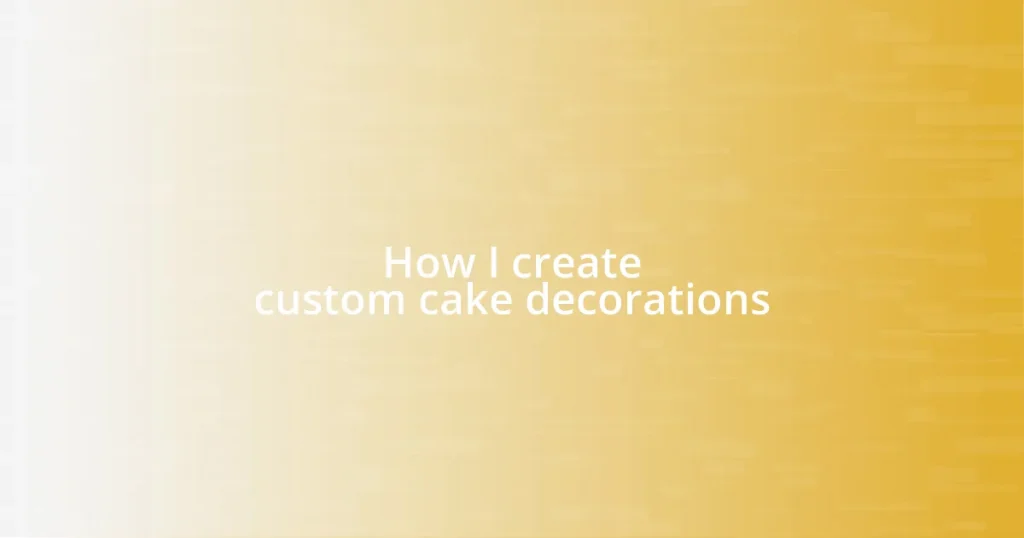Key takeaways:
- Cake decoration techniques, such as piping and ganache pouring, allow for creativity and unique aesthetic expressions.
- Designing custom cake decorations should reflect personal themes, color palettes, and meaningful elements related to the occasion.
- The step-by-step decoration process includes gathering tools, leveling layers, applying a crumb coat, and finalizing the design with personal touches.
- Finishing touches, like edible glitter and fresh flowers, enhance the cake’s visual appeal and create a memorable experience for the occasion.

Understanding cake decoration techniques
When I first dove into cake decoration, I was overwhelmed by the array of techniques available. From piping to fondant work, each method has its own unique charm and can drastically change the cake’s aesthetic. I vividly remember the first time I successfully piped a buttercream rose; it felt like I had unlocked a hidden skill, and that rush of accomplishment was addicting.
One technique that really captured my heart is the art of ganache pouring. I recall a moment when I nervously drizzled warm chocolate ganache over a cake, and to my delight, it created a stunning waterfall effect. Have you ever experienced that perfect blend of nervousness and excitement when trying something new? That’s exactly how I felt, and it pushed me to explore even more intricate designs.
Understanding the fundamentals of each technique can transform your decorating game. For instance, knowing the difference between whipped cream and buttercream can not only impact your cake’s flavor but also its stability. Each decision in the decorating process invites an opportunity for creativity and expression, and isn’t that what makes cake decorating so rewarding?

Designing your custom cake decorations
Designing custom cake decorations is where the magic begins, and it’s all about reflecting your personality and the occasion. One memorable experience for me was creating a cake inspired by my sister’s love for the ocean. I used shades of blue and green fondant to craft seashells and coral, and the look on her face when she saw it was priceless. In that moment, I realized how powerful cake designs can be in evoking emotions and memories.
To consider when designing your custom cake decorations:
- Theme Alignment: Ensure your design matches the party theme for a cohesive look.
- Color Palette: Select colors that resonate with you or the event’s vibe; they should evoke the right emotions.
- Personal Touches: Incorporate elements that represent the individual or occasion, like hobbies or favorite colors.
- Texture Variety: Mix different textures, such as smooth fondant with rougher elements, to create visual interest.
- Size and Shape of Cake: The cake’s dimensions can influence design—taller layers allow for more elaborate decorations.
Reflecting on these aspects not only helps in creating an eye-catching centerpiece but also in making the cake deeply personal to those celebrating.

Step by step decoration process
Certainly! Here’s the content for the “Step by step decoration process” section.
For me, the step-by-step decoration process is a thrilling journey that embraces creativity at every turn. I usually start by gathering all my tools and ingredients. This preparation phase is crucial. Once everything is laid out, I can’t help but feel a surge of excitement. The first step is always leveling the cake layers to ensure they look neat and tidy. I remember my first experience with this—my hands shook a bit as I made those initial cuts, but seeing the perfectly flat layers gave me such satisfaction.
Next, I apply the crumb coat, a thin layer of frosting that locks in those pesky crumbs. Can you relate to that moment of anxiety while spreading it on? I used to worry that I’d make a mess, but over time, I learned that a little patience and a smooth-hand concern will yield a beautiful finish. The final decoration involves all the creative flair you want to throw in. I often enjoy piping intricate designs around the edges, and that’s where I let my personality shine.
When you’re decorating, it’s also important to keep a clear vision of your design in mind. I once got carried away with too many elements, resulting in a chaotic cake. Now, I remind myself to focus on a few key features that complement each other. This way, the end result remains visually stunning without feeling overwhelming.
| Step | Description |
|---|---|
| 1. Gather Tools | Collect all necessary tools and ingredients to prepare your workspace. |
| 2. Level Cake Layers | Use a serrated knife to level the tops of the cake layers for even stacking. |
| 3. Apply Crumb Coat | Spread a thin layer of frosting to seal in crumbs before your final coat. |
| 4. Final Decoration | Add your desired frosting and decorative elements according to your design plan. |

Painting and coloring your designs
Painting and coloring your cake designs can truly elevate them from simple to spectacular. I remember the first time I experimented with edible paints; I was nervous but excited. With each brushstroke, I felt like an artist bringing my vision to life. Using colors to enhance fondant figures or delicate flowers adds depth and vibrancy, and it allows my personality to shine even more. What’s your favorite color to work with when painting?
When it comes to edible colors, I find that quality matters immensely. I always opt for gel-based or airbrush colors because they provide richer hues and don’t alter the texture of the cake. Each time I’m painting intricate details, I take a moment to really appreciate how these colors interact with each other. For instance, a soft lavender combined with a touch of silver dust can create a dreamy effect that captivates everyone at the party. Have you ever tried mixing colors to create a unique shade?
One technique I absolutely love is using a watercolor effect with food-safe brushes. It gives an ethereal quality to my designs that makes them feel almost magical. I’ve hosted friends who were amazed at how simple techniques can result in such stunning visuals. One time, I created a cake that looked like a sunset, with gentle transitions of orange, pink, and purple. Seeing the delight in my friends’ faces was worth all the effort. Painting and coloring your designs is not just about aesthetics; it’s about creating a memorable experience—a canvas of joy to celebrate life’s moments.

Adding finishing touches to decorations
Once the main decoration is complete, I love adding those crucial finishing touches that make a cake truly stand out. A delicate sprinkle of edible glitter or a gentle drizzle of a contrasting glaze can transform the ordinary into the extraordinary. I remember crafting a birthday cake where I added gold luster dust. Seeing it catch the light was exhilarating, and guests couldn’t stop complimenting the shimmering effect. Have you ever experienced that moment when a small detail suddenly elevates your work?
Adding fresh flowers is another favorite storytelling element in my decoration process. The first time I adorned a cake with blossoms, I felt an instant connection between the natural beauty of the flowers and the sweetness of the cake. I always make sure to use food-safe varieties and wash them carefully, as they can breathe life into a design. The vibrant colors and textures of flowers are like nature’s own finishing touches, bringing a refreshing touch of elegance. Do you have a go-to flower for your cakes?
Finally, I oftentimes incorporate personalized elements like handcrafted toppers or quotes that speak to the occasion. For example, during a baby shower, I created a whimsical topper that featured a tiny handmade teddy bear. The look on the mother-to-be’s face when she saw it melted my heart. Personal touches like these connect the cake to its celebration, making it memorable for everyone involved. What are your favorite personal touches that you’ve added to a cake?















